K → π ν ν
KL→π0νν
K+ → π+ ν ν
Since the experimental uncertainties are under control and improvement
is expected on the experimental side, the measurement of
BR(K → π ν ν )
will play a major role in the UT fit in the next future. The BR value
can be related to ρ and
η parameters through the
relation
|
(ση )2+
(ρ -
ρ0 )2
=
|
σ
BR(K+ → π+ ν ν )
κ+|Vcb|4
X2(xt )
|
which is represented by an ellipse centered in
(ρ0 ;0 ).
Several theoretical quantities enter the formula:
-
X(xt ), which is the term parameterizing top quark contribution
to the decay. It's value is known at the NLO in QCD and it's main
uncertainty comes from the value of top mass. We use X(xt ) =
1.51 ± 0.05, which comes from the MS
value for top quark mass.
-
κ+, which can be written as
|
κ+ =
rK+
|
3α2BR(K+ → π0 e+ν)
2π2sin4ΘW
|
where ΘW is the EW symmetry breaking angle and
rK+ takes into account the Isospin symmetry breaking
effects. We take κ+ =
7.50 • 10-6.
-
σ, function of the sine of Cabibbo angle,
-
ρ0, which can be written as
|
ρ0 = 1 +
|
λ4P0(X)
|Vcb|2X(xt )
|
being
|
P0(X) =
|
1
λ4
|
[
|
2
3
|
XeNL +
|
1
3
|
XτNL]
|
the parameter that describe the perturbative charm contribution. We calculate
P0(X) with the expression provided by Buras et al..
The values for X(xt), κ+ and
P0(X) are taken from
G. D'Ambrosio and G. Isidori, hep-ph/0112135,
while for the experimental determination we use
BR(K → π ν ν ) = (1.47 +1.30, - 0.89) • 10-10
from A.V. Artamonov,
et al. [E949 Collab.], hep-ex/0403036.
The constraint is represented by an ellipse (an elliptical crown once the uncertainties are taken
into account). The error on the actual measurement is still too large to allow an improvement
of the determination of ρ and
η.
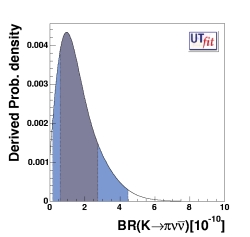
(EPS)
[JPG]
|
Likelihood BR(K → π ν
ν)
(from the derivative of experimental CL)
|
|
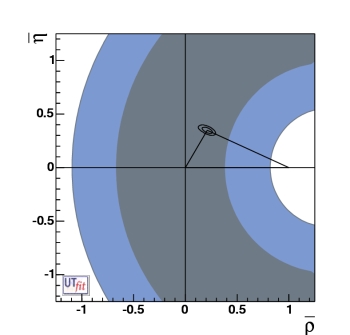
(EPS)
[JPG]
|
bound from K → π ν
ν
from present experimental
measurement,
compared to the standard UTfit result
|
|
We studied the bound one can get from 100 observed events, the error coming from Poissonian
fluctuations (i.e. assuming an optimistic scenario of complete rejection of background),
to quantify the impact of the next generation of experiments (such as NA48 3).
We repeated this exercise with the SM central value (0.83x10-10)
and the present experimental result,
using the present theoretical error on the long distance charm contribution or
assuming a factor two in the reduction of it.
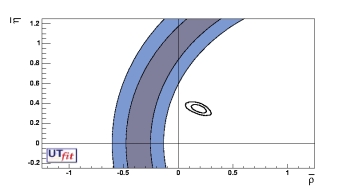
(EPS)
[JPG]
|
bound from K → π ν
ν
assuming 100 events, the present central value and
present theoretical error
|
|
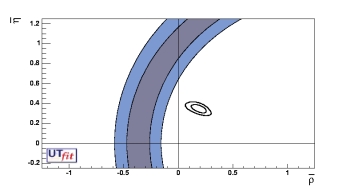
(EPS)
[JPG]
|
bound from K → π ν
ν
assuming 100 events, the present central value and
1/2 theoretical error
|
|
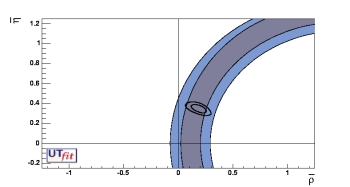
(EPS)
[JPG]
|
bound from K → π ν
ν
assuming 100 events, the SM central value and
present theoretical error
|
|
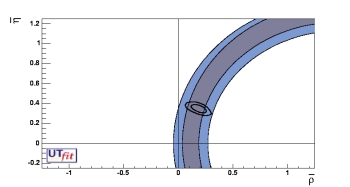
(EPS)
[JPG]
|
bound from K → π ν
ν
assuming 100 events, the SM central value and
1/2 theoretical error
|
|
KL → π0 ν ν
The knowledge of BR(KL → π0 ν ν) provides
a measurement of η2, through the relation
|
BR(KL → π0 ν ν) = κL
|
Im(λt)2X2(xt)
λ10
|
where κL is a theoretical correction similar to κ+ (introduced for the case of
K → π ν ν decay) and
related to it through the relation
|
κL= κ+
|
rKL
rK+
|
τ(KL)
τ(K+)
|
where τ(KL) and τ(K+) are kaon lifetimes and rKL = 0.944 ± 0.028
represents the isospin breaking correction. This constraint
is sensitive to new
physics in a complimentary way respect to the bounds
currently used in the UTfit. Waiting for an experimental measurement
of BR(KL → π0 ν ν), we can
compare the present bounf from UTfit with a hypothetical 10% precise
measurement.
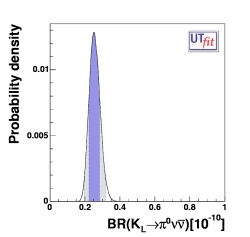
(EPS)
[JPG]
|
UTfit Prediction
BR(KL → π0 ν
ν)
= (0.25 ± 0.03)10-10
|
|
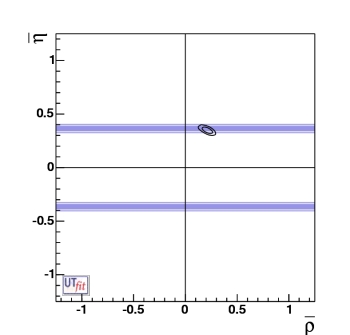
(EPS)
[JPG]
|
bound from KL → π0 ν
ν
assuming 10% precision
on the BR and agreeement
with respect to the Standard Model
|
|
Combining the hypothetical 10% precise measurements on
BR(K → π ν ν) and
BR(KL → π0 ν ν)
to the present knowledge on εK,
one can illustrate the impact of Kaon physics on the UTfit at the end of the next
generation of K-physics experiements. To do that, we assumed two different scenarios,
in agreement (left) or disagreement (right) to the Standard Model expectations
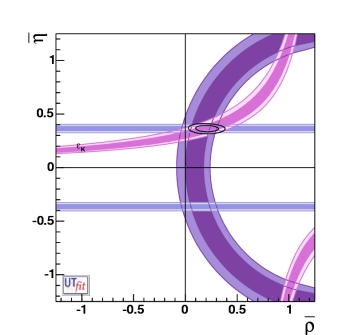
(EPS)
[JPG]
|
impact of Kaon physics to the UTfit, assuming
agreement between rare kaon decays and the SM
|
|
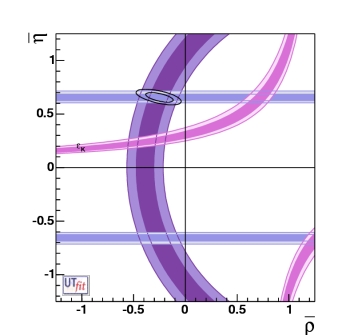
(EPS)
[JPG]
|
impact of Kaon physics to the UTfit, assuming
disagreement between rare kaon decays and the SM
|
|
